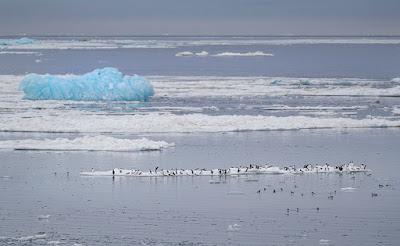This second group of Arctic birds are those I consider more exotic for one reason or another.
We expected to see Common Eiders on our trip and we weren't disappointed. I think they are beautiful birds even though they are often overlooked in favor of their more colorful and more rare relatives, the King Eiders. Several people warned us we were unlikely to see the latter as they are uncommon but in fact we saw quite a few more King Eiders than Commons!
We had the opportunity to photograph Common Eiders close up near the town of Longyearben but I prefer this image of a male and female pair flying in front of a glacier.Although we saw far more King Eiders than we expected, the sightings were always at some distance. Still, it is easy to see why they are so sought after as the colors of the males are quite spectacular.
One of the birds I was really hoping to see was the Pink-Footed Goose. I finally had my chance to photograph a small group as they flew in front of a Kittiwake nesting wall. You will probably have to click on the image to really see the geese as they blend in so well with the background.
We saw a few individual Puffins in the water but no groups. I believe we were too early for the nesting time.
Another bird we saw quite regularly was the Purple Sandpiper. I really don't know how they got their name as they did not appear to be purple!
My favorite bird images from the trip are those of the Red Phalaropes. This is the only bird species I have ever seen where the female is more colorful than the male. There is a good reason for the difference in coloring - in this family the female lays the eggs but the male then takes over and does all the work of raising the chicks, including sitting on the nest. He is more dully colored so he will be less visible. Red Phalaropes live almost their entire lives at sea. They are partners with the Blue Whales that they follow around for the majority of the year, finding food where the big mammals feed. They are only on land long enough to mate and raise their young and then back to sea they go.
This pair of Red-throated Loons is a little distant to really appreciate their beautiful markings but they were a treat to watch.
 Last but not least is another predator of the bird world, the Arctic Skua. We saw three of the four types of Skuas on our trip but none as close as this one who was protecting her "scrape" (nest) on the ground amidst the Purple Saxifrage.
Last but not least is another predator of the bird world, the Arctic Skua. We saw three of the four types of Skuas on our trip but none as close as this one who was protecting her "scrape" (nest) on the ground amidst the Purple Saxifrage.
















































